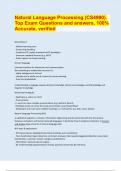Exam (elaborations)
Natural Language Processing (CS4990). Top Exam Questions and answers, 100% Accurate, verified
- Course
- Natural Language Processing
- Institution
- Natural Language Processing
Natural Language Processing (CS4990). Top Exam Questions and answers, 100% Accurate, verified Why Python? - Shallow learning curve - Good string handling - Combines OO, aspect-oriented and FP paradigms - Extensive standard libraries (e.g. NLTK) - Great support for Deep Learning Human lan...
[Show more]



